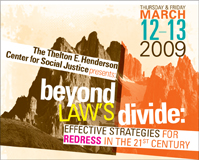Beyond Law’s Divide: Effective Strategies for Redress in the 21st Century
March 12-13, 2009
Thelton E. Henderson Center for Social Justice
Co-sponsors:
Institute for the Study of Social Change
University of Hawi’i at Manoa, William S. Richardson School of Law
Equal Justice Society
Critical Race Scholars Society
Native American Law Student Association
Law Students of African Descent
Agenda Panelist Profiles Register Lodging Parking-Directions Sponsor Profiles
The legal tools available to subordinated, colonized, and under-resourced communities of color and indigenous people in the last several decades have limited the reach of their redress and served to divide them from one another. In this new century the problems facing such communities are considerably more complex and nuanced than the barriers they faced in the last.
For people of color, the legal doctrines have centered on individual civil rights and the intent doctrine in discrimination law. Critical race theory has expanded theoretical scholarship in the academy but its effect on court opinions and the lives of most people of color has been negligible. For Native people, the concentration has been on the trust doctrine and dependent sovereignty as the law’s classifications have failed to recognize the complexity of indigenous racial, ethnic, and political identities. And despite the fact that the courts have been constricting the interpretation of the laws upon which all such groups rely for redress, the struggles continue to focus on litigation strategies.
While legal theories and approaches have provided some advances for communities of color including Native peoples and tribes, the reality is that they have not resulted in the goals of true self-determination and control on the one hand or equality on the other. Indeed, they have often been unsuccessful in delivering even their promised protections and benefits.
It is easy to identify the difficulties. While scientific research about the human brain and critical race theories have advanced our understanding about discrimination, subordination, and colonization, both our legal doctrines and our approaches have too often failed to keep pace with this new knowledge. The litigation-centered experience of the older generations too often resists the ideas and perspectives of younger ones. Academics and practitioners tend not to venture beyond their own silos. Communities of color and indigenous groups do not talk to each other. Lawyers hesitate to stray beyond their particular subject matter. Yet he task of repairing the harms resulting from discrimination and subordination is so multi-dimensional and complex that it requires an approach that includes all voices and perspectives and facilitates the kind of dialogue and cross-pollination that can serve as catalysts for change.
This symposium asks if we can re-envision these old constructs based on the law’s divide and collaborate across identity groups and disciplines to forge new theories and practices for redress in this new century. Can communities of color and indigenous peoples focus on the similarities of their histories and experiences and learn from one another how to incorporate threads of group rights, political rights, human rights, and individual civil rights in their approaches to problems? Can critical race theorists inform the work of judges and practitioners? Can identifying common interests and concerns actually achieve greater progress than the battleground of litigation with victors and victims?
We are bringing academics and practitioners from around the country in a collaborative effort to envision workable strategies for redress in the 2lst century that apply theory to practice, develop the common ground among communities of color and indigenous groups, work across subject matters and disciplines, and recognize that law is one among many tools for social change. The aim of the symposium is frankly visionary; the lens is not on next year but on the next decade. We intend to begin planting the seeds that will flower in future years.
The symposium builds upon the work of previous Henderson Center symposia on dismantling the intent doctrine in discrimination law in the United States (with the Equal Justice Society) and on transformative justice in communities of color and indigenous groups internationally. It also incorporates the work of law students in the Scholar Advocate program at Berkeley Law and of graduate students at the Institute for the Study of Social Change.
Speakers listed under “Panelist Profiles.”
Please note:
There is no charge for this event.
The Symposium is wheelchair accessible. For disability-related accommodations please contact csj@law.berkeley.edu or (510) 642-6969.
MCLE credit will be issued on the days of the event only.
